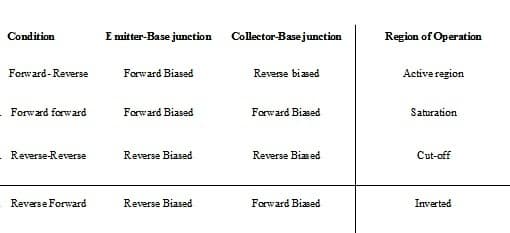Transistor Biasing
Biasing of the transistor:
1. We know that for normal operation of the transistor the first junction i.e. the emitter base junction should be forward biased and the collector base junction to be reverse bias.
2. But the transistor can be biased in some other way also.
a. Forward- Reverse biasing: Also called as FR biasing. It’s the normal operation of the transistor where emitter base is forward and collector base is reverse bias.
b. The transistor is said to be in the active region.
c. This kind of biasing is used for amplification.
1. Forward- forward biasing: Also called as FF biasing. In this both the junctions are forward biased.
2. The transistor is in the saturation region. Here the collector current is independent of the emitter current.
3. The transistor acts as a closed switch.
a. Reverse- Reverse Biasing: Here both the junction are reverse biased.
b. Here there is no flow of current through the transistor.
c. It acts as open switch
d. It is in cut-off region.
1. Reverse- Forward Biasing: Here the emitter base junction is reverse bias and the collector base junction is forward biased.
2. Then the transistor works in inverted mode of operation.
3. The design is conceptually significant

1. We know that for normal operation of the transistor the first junction i.e. the emitter base junction should be forward biased and the collector base junction to be reverse bias.
2. But the transistor can be biased in some other way also.
a. Forward- Reverse biasing: Also called as FR biasing. It’s the normal operation of the transistor where emitter base is forward and collector base is reverse bias.
b. The transistor is said to be in the active region.
c. This kind of biasing is used for amplification.
1. Forward- forward biasing: Also called as FF biasing. In this both the junctions are forward biased.
2. The transistor is in the saturation region. Here the collector current is independent of the emitter current.
3. The transistor acts as a closed switch.
a. Reverse- Reverse Biasing: Here both the junction are reverse biased.
b. Here there is no flow of current through the transistor.
c. It acts as open switch
d. It is in cut-off region.
1. Reverse- Forward Biasing: Here the emitter base junction is reverse bias and the collector base junction is forward biased.
2. Then the transistor works in inverted mode of operation.
3. The design is conceptually significant

0
